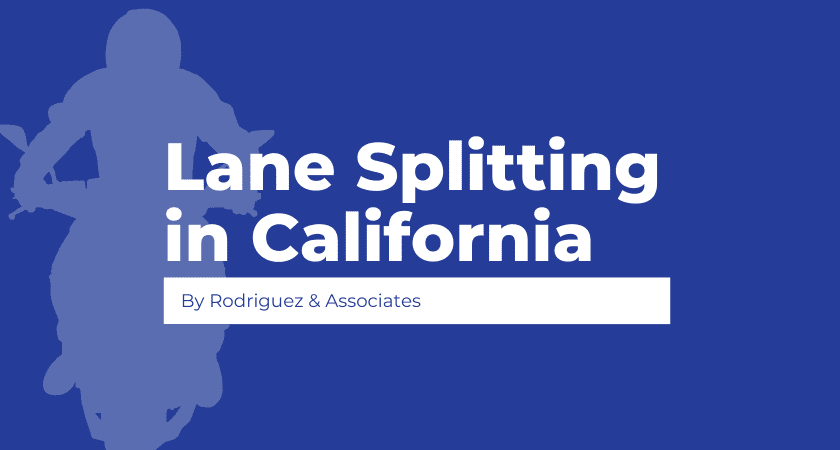If you’ve ever been stuck in traffic and seen a motorcycle create its own lane by zipping between your car and the one next to you, you’ve witnessed what’s called lane splitting. It’s a common move for motorcyclists on freeways and crowded streets. It also causes its fair share of controversy.
Lane splitting enjoys a special privilege in California, one of the only U.S. states where the move is actually legal. While it’s a time-saver for motorcycle riders and, by some arguments, safer, lane splitting also causes a lot of tension on the roads. If not done correctly and carefully, it’s a risky move, and even when a motorcyclist is doing it responsibly, drivers of surrounding passenger vehicles often find it stressful and confusing.
The move’s legal status in California also complicates the process of determining fault when there is an accident involving lane splitting. Drivers of passenger vehicles should be aware of certain regulations — for motorcyclists and themselves — around lane splitting when they get behind the wheel. In the event of an accident, it is helpful to know these things up front.
Lane Splitting Basics
In 2016, Gov. Jerry Brown signed Assembly Bill 51 into law in California, which officially made lane splitting’s status legal. The law defines lane splitting as “driving a motorcycle, that has 2 wheels in contact with the ground, between rows of stopped or moving vehicles in the same lane, as specified.”
Following the signing of AB 51 into law, the California Highway Patrol (CHP) developed certain guidelines around lane splitting, which were released in 2018. The CHP’s guidelines are meant to somewhat regulate the practice of lane splitting to make it safer for both motorcyclists and other vehicles around them. That said, they are guidelines only — not laws.
For example, there is no law dictating the maximum speed at which a motorcyclist can lane split. Guidelines and officers of the CHP have said a motorcyclist should be going no more than 10 miles per hour over the speed of other vehicles. So if slow-moving traffic on the freeway is inching along at 20 mph, a motorcyclist should not be lane splitting faster than 30 mph. Motorcyclists should never go above 50 mph while lane splitting. They should also split on the far left lane and avoid splitting next to large vehicles (buses, big rigs).
While none of these things are law, police can still ticket a motorcyclist that is driving recklessly while lane splitting. Riding on the shoulder of the road or freeway is illegal and never considered lane splitting.
The CHP also notes in its guidelines that “Lane splitting can be dangerous and extreme caution should be exercised” and that “The risk of death or serious injury during a lane splitting collision increases as speed and speed differential increases.”
Car Accidents and Lane Splitting
If you are in an accident with a motorcyclist that was lane splitting, be prepared for a complex journey in terms of filing a claim. In other states, where lane splitting is illegal, the fault would obviously lie with the motorcyclist that was lane splitting. Because of the move’s legal status in California, determining liability isn’t a clear-cut process.
In such an accident, any number of parties could be to blame: the motorcyclist, the other driver, even local government agencies.
As mentioned above, a motorcyclist can still be ticketed if they are driving recklessly while lane splitting. In the event of a crash, they could be held liable if they were not following the CHP’s guidelines. For example, the CHP’s guidelines instruct motorcycle drivers to avoid other cars’ blind spots. If your accident occurs because the biker was lane splitting in your blind spot, they might be at fault.
On the other hand, drivers of other vehicles need to make sure they are following a few rules themselves.
While lane splitting can be frustrating for drivers of passenger vehicles, because it is legal in the state of California, you cannot intentionally block someone from lane splitting. In fact, it is illegal to do so. If you are doing this and an accident happens, you could be held partially or even fully responsible for the crash.
Drivers should also be on the lookout for motorcyclists before they change lanes, and always use their car’s signals when turning or switching lanes. While these are common-sense practices in most driving situations, they are important to follow when it comes to sharing the road with those on motorcycles.
Sometimes, the fault lies elsewhere, like with the government. A great example of this is poorly maintained roads. If the road itself is not kept in good repair by the state of California, which in turn makes it more difficult for the motorcyclist to switch lanes, the fault of the accident could lie with a government agency.
More often than not, the fault will lie with no one single party and will be a combination of multiple factors. However, in order to receive the compensation you deserve after this type of accident, it is best to consult an attorney. This person should not only have experience with car and motorcycle accidents, they should ideally have handled past cases involving lane splitting. Determining fault and filing a claim for compensation especially in this case can be a challenging process. To minimize your frustrations, seek the help of an experienced Bakersfield personal injury lawyer.
Rodriguez & Associates has long been committed to helping drivers protect their rights and receive the compensation they deserve from motorcycle accidents. If you or a loved one has been involved in a crash, please reach out to us today ((661) 777-7575) for a free consultation.
